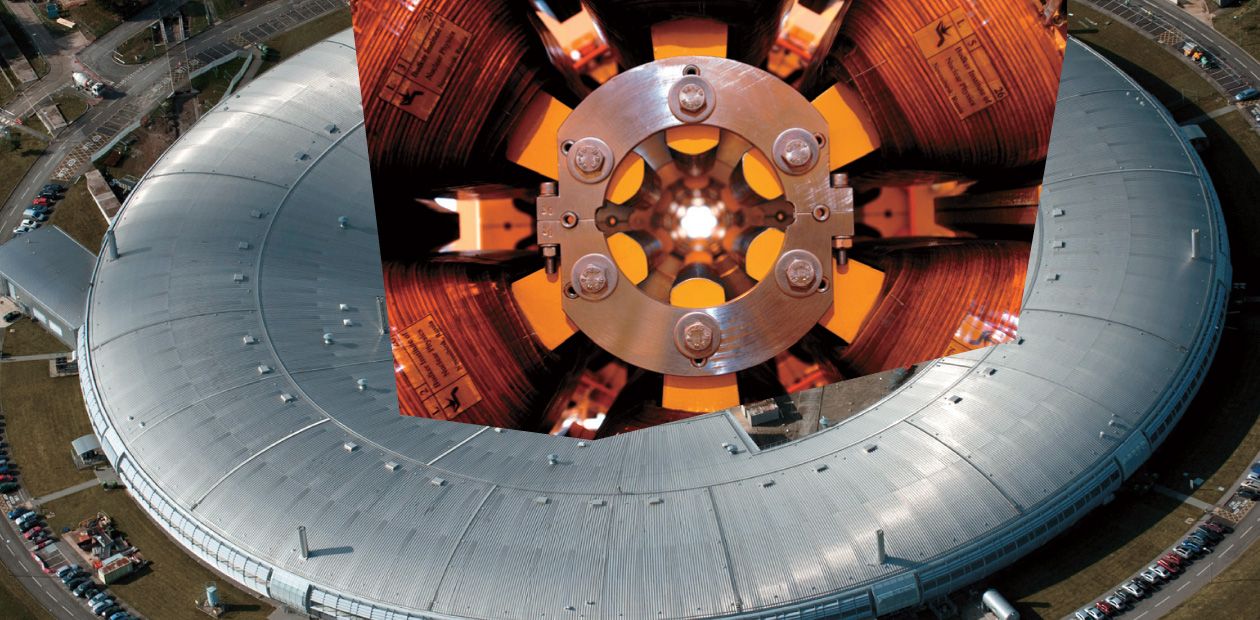Diamond Light Source: The Jewel in the Crown of UK Science and Innovation
In February 2015, the Budker Institute of Nuclear Physics, Siberian Branch, Russian Academy of Sciences (INP SB RAS, Novosibirsk) hosted the Russian-British roundtable “New Horizons of Accelerator Technology: The Present and Future of Bright Synchrotron Radiation Sources,” which was organized by the UK Science and Innovation Network (SIN)-Russia, based in the British Embassy in Moscow, with the participation of Profs. Richard Walker, Andrew Harrison, and Andrei Seryi, on the part of the United Kingdom, and the leading researchers of the INP SB RAS (Novosibirsk) and the Kurchatov Institute RAS (Moscow), on the part of Russia.
There is a long tradition of such cooperation. In the 1970s, British researchers, who did not have their own source of synchrotron radiation (SR) at the time, visited Novosibirsk Akademgorodok within an academic exchange program. Novosibirsk physicists, in turn, participated in the development of the UK's synchrotron facility Diamond Light Source (Diamond). Professors Harrison and Walker, from Diamond, told the editors of SCIENCE First Hand about the organization and the main avenues of activity of the facility and outlined the wide range of services offered. These are available on a competitive basis to researchers from many countries worldwide, including Russia
Synchrotron radiation (SR) is historically known to be a "by-product" of research in high-energy physics; therefore, initially, the only source of SR was accelerators designed to study elementary particles, which provided a very limited SR output. The subsequent reconstruction of these accelerators, which involved the design of special storage rings, did not solve the problem entirely since it was only possible to use particle beams of relatively low energy.
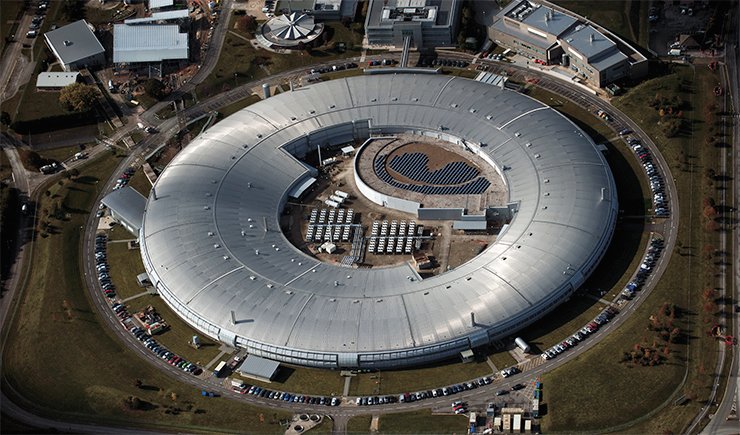
The world's first second-generation source, which was designed exclusively for SR, i.e., an electron storage-ring accelerator boosting electrons to 2 GeV, was built near Daresbury in the English county of Cheshire and successfully worked from 1981 to 2008. It was succeeded by the accelerator facility Diamond Light Source (Diamond), which became the UK Government’s largest single investment in science for over forty years. Diamond is a third-generation SR source, characterized by a high spectral brightness and spatial coherence of the radiation through the use of specialized insertion devices (wigglers and undulators) and bending magnets.
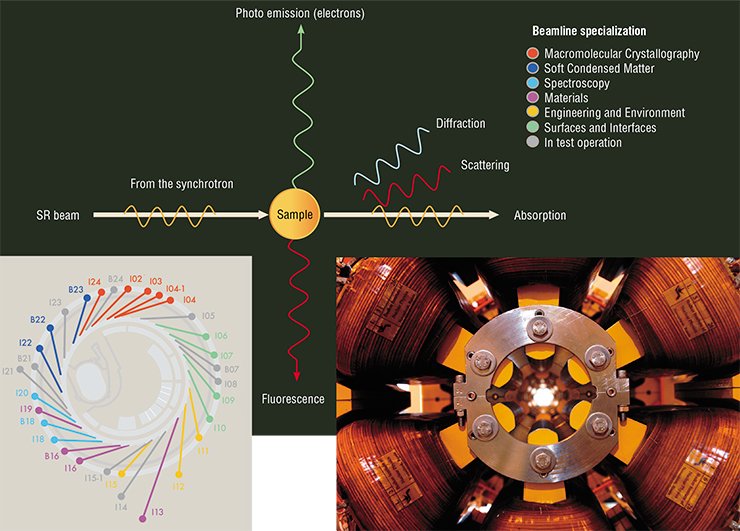
The construction of Diamond began in South Oxfordshire in March 2003; the first seven beamlines opened their doors for users in January 2007. It should be noted that Russian experts also took part in the construction, including representatives of the INP SB RAS, which supplied 168 hexapole magnets and 2 superconducting insertion devices for JEEP, the Joint Engineering and Environmental Processing beamline (I12) and the Extreme Conditions beamline (I15), which were built during the first phase of Diamond’s construction.
When Diamond began operations, it was one of the brightest SR sources in the world: it accelerates electrons to an energy of 3 GeV and the specialized insertion devices make the SR ten orders of magnitude brighter than the solar radiation in a wide range of wavelengths (6∙10–12 to 2∙10–3 m). These parameters enable scientists to obtain information at the atomic level and, if necessary, in real time, which, in turn, makes it possible to solve a wide range of problems in the most critical fields of modern science and technology, from structural biology to catalysis and nanotechnology.
From fragile protein crystals to...
Diamond started its operations with three beamlines for crystallographic studies of macromolecules. The reason was a high demand on the part of a very active community of structural biologists in the United Kingdom. X-ray crystallography, a popular technique for determining the structure of proteins that stems from the work of William Henry Bragg and William Lawrence Bragg in the 1910s. It allows one to use diffraction patterns obtained by lighting a crystallized sample with X-rays in order to determine the exact positions of atoms in an object. It was the X-ray crystallography method that helped scientists to discover the well-known DNA double helix; today this method is widely used to study a variety of biomolecules and more complex biological objects such as viruses. It can also be used to develop nanomaterials and energy storage solutions such as Metal Organic Frameworks (MOFs).
Today, Diamond Light Source is the only synchrotron in the world to have a unique laboratory within the building for the study of membrane proteins. A quarter of all known proteins are embedded or associated with cell membranes or organelles, and these proteins are a target for more than a half of all modern drugs. For X-ray analysis, proteins are usually converted into the crystalline form; however, the crystallization of membrane proteins is a challenge. The fact that the laboratory is located just a few meters from the SR beam is very helpful in the study of these “delicate” protein samples.
A HEALTHY TODAY More than 40% of the studies conducted at Diamond, the UK synchrotron facility, pertain to life sciences. Researchers analyse the atomic and molecular structure of viruses and bacteria causing human and animal diseases and investigate the cellular processes leading to pathologies, and pharmaceutical companies test the potential drugs.One of the global challenges of modern health care is drug resistance. Microorganisms—from bacteria to fungi—have developed resistance to drugs, including many antibiotics. Since the mechanisms underlying the drug resistance are highly diverse, the ways to combat them should also be diverse. The studies of gram-negative bacteria, which cause a wide range of infectious diseases, from salmonellosis and gonorrhoea to meningitis, showed that the bacteria’s surface is covered with a camouflage of lipopolysaccharide molecules, which protect the bacteria from the human immune system and serve as a barrier against antibiotics. Synchrotron studies were able to accurately determine the structure of the bacterial protein responsible for the final phase in the creation of this protective shield. These results can be used to develop a new generation of antibiotics active against a broad spectrum of pathogens (Dong et al., 2014).
Another step in understanding how bacteria can trick the human immune system is to study the structure and operation of the molecular ruler that regulates the synthesis of polysaccharide polymers in bacterial membranes. This process is similar to cutting off a piece of cloth from a roll: when the polymer grows to a certain length, its synthesis stops. While the molecular ruler concept dates back to the beginning of the 1970s, it was SR that enabled scientists to visualize this protein at the molecular level. Although this work pertains to structural biology, it can give chemists an elegant solution to control polymerization, which is a problem for many industrial processes (Hagelueken et al., 2014).
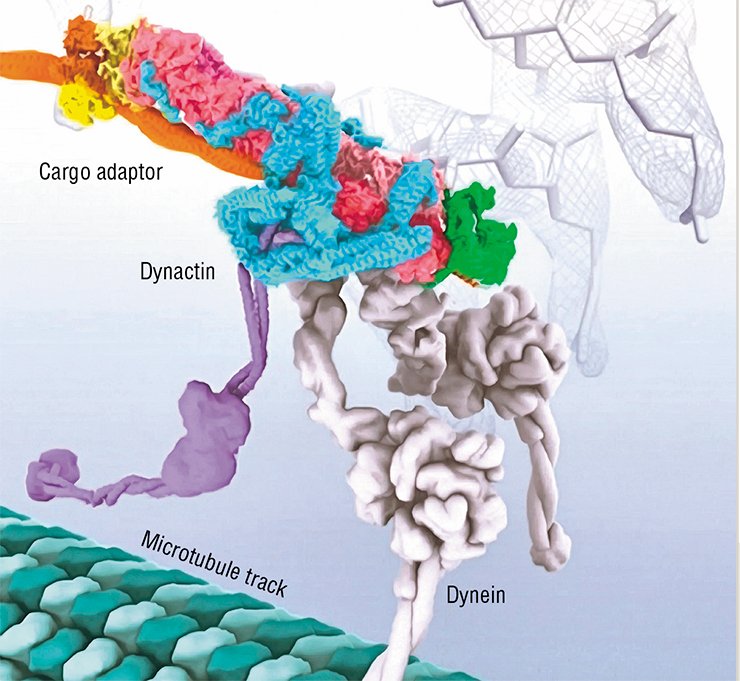
Today, about a third of the world’s population are infected with tubercle bacillus: after HIV, this bacterium kills more people than any other infection. Every year, more and more people get infected with the drug-resistant form of tuberculosis; these bacilli are much more aggressive and resilient than the ordinary ones. It is difficult to combat this infection because the bacilli have a special protective wax coating. The enzyme involved in the production of this substance was discovered 18 years ago; however, it took about 15 years for scientists from the Universities of Oxford and Kingston to obtain one bacterial protein crystal, which is smaller than a pinhead! A SR analysis of this truly precious crystal allowed researchers to establish a clear symmetry and spatial structure of the protein, which will be a potential target for new antituberculosis drugs.
There are great pharmaceutical prospects for the results of synchrotron studies of human cells’ transport mechanism. One of the key components of this transport network is the dynein protein complex, which acts as a small vehicle carrying different loads across the cell. However, dynein can transport toxic elements as well as useful loads, such as mitochondria or mRNA molecules carrying information about the composition of new proteins. The toxic elements include aggregated proteins that cause the death of nerve cells, which leads to the development of dementia and Parkinson’s disease. Furthermore, dynein can also be captured by viruses (e.g., herpes viruses), which get into the nuclei of nerve cells to provoke an outbreak. Using one of the macromolecular crystallography beamlines (I03) at Diamond, researchers from the University of Cambridge were able to visualize this complex subcellular process and describe how dynein functions as a part of the protein complex.
Synchrotron studies also helped shed light on another neurodegenerative process—Alzheimer’s disease. The studies revealed that the formation of beta amyloid plaques in the affected neurons is accompanied by the accumulation of bivalent iron, a neurotoxic substance. This knowledge opens up new avenues in the development of drugs able to stop this process and in early MRI diagnostics to be carried out before the onset of irreversible brain damage (Everett et al., 2014).
The specially modified crystallographic facilities at Diamond provide unique opportunities for working with viruses, the oldest and the most common living organisms on our planet, many of which are pathogenic to humans. Viruses change so rapidly that it is extremely difficult to reconstruct their evolutionary history, but these data are highly important to successfully confront these infectious agents, which have no cellular structure and are resistant to the majority of the known chemotherapeutic agents.
One of the recent SR-based achievements was the determination of the exact atomic structure of the hepatitis A virus. A team of scientists from Beijing and Oxford found that this virus is likely to be the missing evolutionary link between picornaviruses, which infect humans and animals (these include the polio virus), and those that infect insects. This fact might explain the virus’ high endurance and extraordinary resistance to high temperatures and aggressive environments. It is not surprising that despite the vaccine, this disease continues to affect up to half a million people annually.
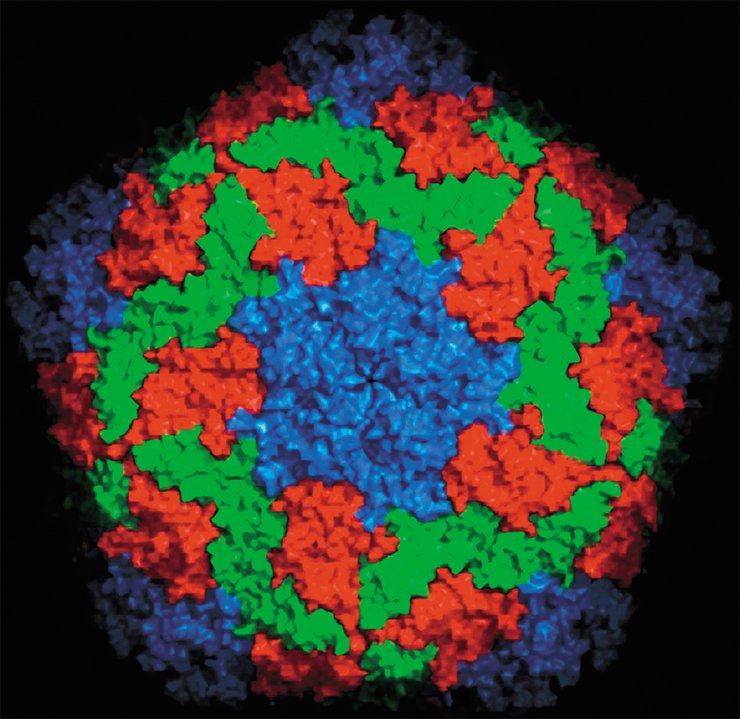
Viruses are a serious threat to farm animals as well as humans. One of the most dangerous infectious agents is the foot-and-mouth disease virus, which killed more than seven million head of cattle in the United Kingdom in 2001. Combating this disease worldwide requires three to four billion doses of the vaccine a year. Microfocus MX beamline I24 was used to develop a new type of vaccine, the basis of which is not the virus itself, but its man-made empty capsid shell. The vaccine contains no live virus, is safer, and remains stable at ordinary temperatures, which is why it is easy to transport and use under any conditions (Porta et al., 2013).
The crystallographic studies at the beamlines are largely automated, and researchers have time to analyse several hundred samples during an eight-hour shift. If the users cannot attend an experiment, they can control it remotely from their home institutions.
Diamond’s achievements in the X-ray crystallography of biomolecules speak for themselves: today, the centre ranks third worldwide in the number of transcribed protein structures stored in the global database. Diamond is also engaged in ongoing research aimed at the development of new drugs to treat cancer, heart diseases, viral and bacterial infections, and at the early diagnosis of neurodegenerative diseases and other pathologies.
…to two-tonne steel samples
However, structural biology and medicine are not the only areas where Diamond has established itself as a leader. Ecologists use the beamlines to find ways to clean contaminated areas; volcanologists and geologists need them to conduct experiments at extreme temperatures and pressures that simulate conditions in the Earth’s interior; archaeologists study ancient art objects; chemists create new materials; technologists test the old ones, etc.
Today, the centre has 25 beamlines of various functions, and 8 more will come online before the end of 2018.
The centre’s unique beamlines include Joint Engineering, Environmental and Processing (JEEP) Beamline I12, which is designed for experiments with high-density materials, including metals. The first experimental hutch is suitable for analysing samples ranging from the size of a grain to a few centimetres. This hutch is located at a distance of 50 m from the source to provide a high intensity beam for diffraction and microscopy experiments. The second experimental hutch, located outside the main building, is used for large-scale and long-term industrial-purpose experiments. Here, researchers can continuously monitor the internal state (crystal structure tension) of engineering facilities under the conditions that simulate the real-life industrial operation. In this case, the samples can be up to several meters long and weigh up to two tonnes!
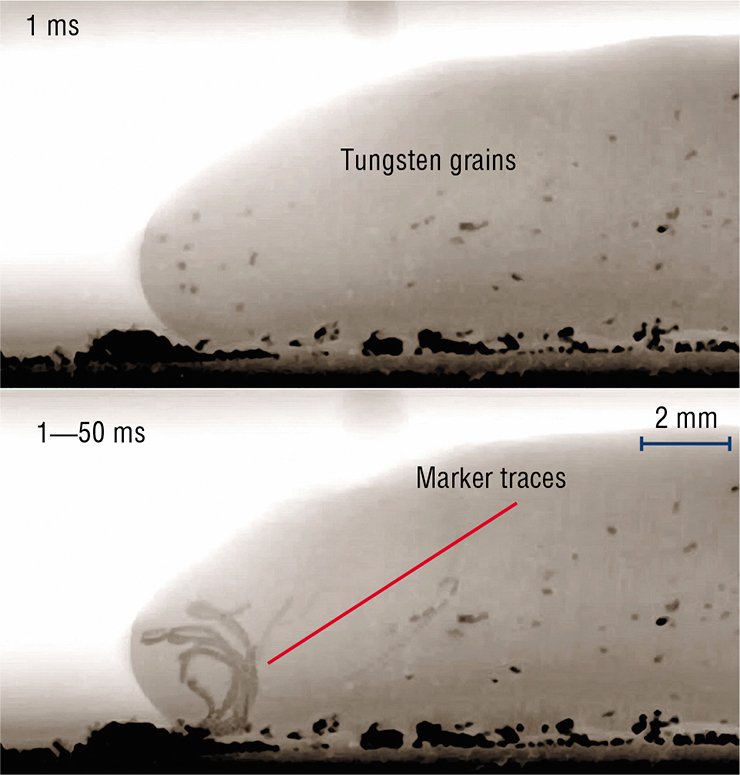
Scientists can track the variability of characteristics of a powder or a polycrystalline sample over long time by using another unique Beamline I11, designed for high resolution powder diffraction. Samples are placed in a special cell, where they can stay from a few weeks to a year or more. The large experimental hutch makes it possible to conduct several parallel experiments with a weekly collection of X-ray diffraction data.
One of the important avenues of research in the modern materials science is structural analysis of surfaces and interfaces (phase boundaries). Beamline I09, which offers Surface & Interface Structural Analysis (SISA), allows scientists to investigate the atomic and electronic structures of materials near the phase boundary with high spatial resolution and chemical selectivity. In so doing, they can simultaneously use a wide range of techniques from photoelectron spectroscopy and photoelectron diffraction to X-ray absorption and reflection spectroscopy. Achieving this simultaneity, as well as effective radiation absorption at the edges of the sample (which is particularly important in the analysis of complex surfaces), has been possible through the use of two undulators installed in the cyclotron obliquely to each other. One of the undulators generates soft (with a wavelength of 1–10 nm) X-rays and the other one generates hard (0.05–0.5 nm) X-rays, whereby the two SR beams illuminate the same spot of the test sample.
Public open days
Diamond Light Source is a national facility, and it spares no effort to give the users—more than 8,000 researchers—the maximum flexibility and best experience. The facility operates around the clock with a six-day working week (with the exception of several planned shutdown periods of two to three weeks for development and maintenance), i.e., about 5,000 hours per year.
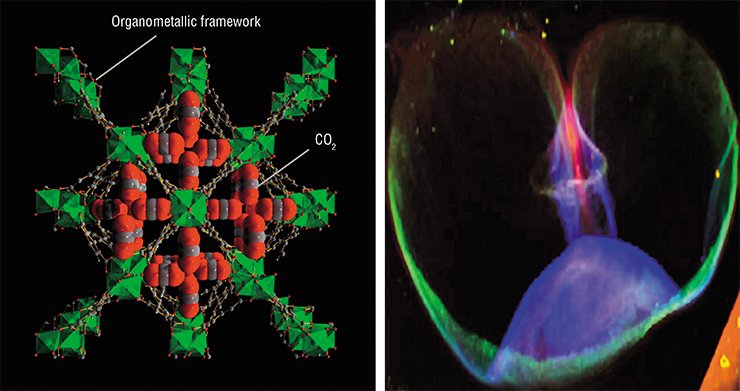
The demand for Diamond’s services exceeds the supply; therefore, applications are accepted on a competitive basis, and the decisions are made not by the company management but by a group of independent experts in various fields of science. The Diamond users comprise researchers from academia and industry as well as unaffiliated individuals. The facility’s services are free of charge, provided that the results are in the public domain; the proportion of these users should be at least 80–90%. There is paid access too, with about 80 industrial customers, and their number is growing in pace with the increase in the number of Diamond’s beamlines. Furthermore, about one fifth of the academic users also declare that their results may be used directly in industry. Enlightening the Past Dinosaurs remain one of the most intriguing mysteries of the remote past. Synchrotron studies of fossilized remains of these prehistoric creatures helped lift the veil of secrecy over their amazing resilience, which enabled dinosaurs to dominate on our planet for millions of years.
A team of scientists from the University of Manchester were the first to use Microfocus Spectroscopy Beamline I18 to investigate the cracks, fractures, and breaks in predator dinosaurs’ bones dating back 150 million years. During an ordinary study, these fossilized bones would be dissected, but synchrotron imaging allowed researchers not only to detect traces of healed injuries, many of which would be lethal to humans, but also to describe the chemical scenario of how dinosaurs’ bones regenerate. Diagnosing the defence mechanisms of these amazing animals is important not only for evolutionary studies: on the whole, the chemistry of the human body and that of some allosaurus are not very different; hence, if we understand the healing process in dinosaurs, we might be able to develop new methods of diagnostics and treatment for many modern diseases.
The synchrotron study of fossilized remains of dinosaurs also discovered an unexpected solution to… the environmental problem of nuclear waste disposal. It was found that calcium phosphate—a key element of the bone tissue—has the ability to bind radioactive elements from the environment in which the bones were buried. This substance can serve as a basis to design chemical structures that can retain nuclear waste for extended periods of time.
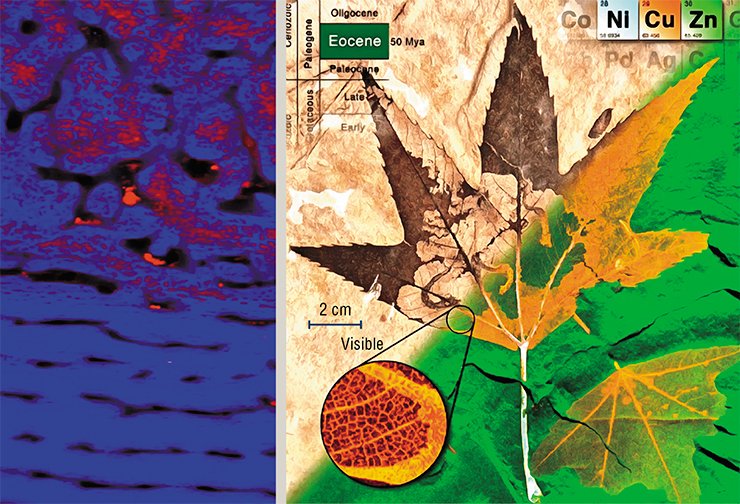
The scope of synchrotron studies goes beyond fossil animals: a team of scientists from the University of Manchester, Diamond Light Source, and the Stanford Synchrotron Radiation Laboratory used microfocus spectroscopy to confirm that the elemental composition of petrified plants has remained unchanged for hundreds of millions of years. It turns out that the distribution of copper, zinc, and nickel in the well-preserved fossil leaves of the Eocene epoch is very similar to that in the leaves of modern plants. Copper appears to have acted as a natural antibiotic slowing the normal microbial decay in the delicate leaf tissue. This opens up the possibility of studying a part of the biochemistry of ancient plants, so in the future, it may enable us observe the changes, if any, in the use of metals by the plant kingdom through geological time.
Thus, synchrotrons have made it possible for creatures that died millions of years ago to help researchers obtain results at the forefront of modern science, from the development of safe industrial technologies to biomedical research. As Prof. Phil Manning of the University of Manchester, one of the UK’s leading experts on dinosaurs, so aptly put it, “Science isn’t just about answers; it’s about asking really good questions.”
Diamond also offers training for undergraduate and graduate students (currently there are around 70 PhD students at Diamond, and 50 of them receive special scholarships) and technical staff. As part of the education programme, Diamond welcomes 2,000 students each year. Every three months, Diamond opens its doors to members of the public and welcomes around 1,500 visitors each year. They are from various age groups and backgrounds, but they are all interested in learning about research at the forefront of modern science.
Looking into the Future The great opportunities of synchrotrons are now widely used in materials science and engineering to develop new materials and efficient and environmentally friendly industrial technologies.Thus, an important problem associated with the processing of crude oil is to separate complex mixtures of gaseous hydrocarbons into individual, pure ingredients. The commonly used method is cryogenic distillation, which requires enormous amounts of energy to maintain high pressures and low temperatures. An innovative solution was a new porous organometallic material, a kind of a “chemical sponge” made of available components and able to absorb various components from oil at different rates. A study at Diamond confirmed the excellent performance of the new material NOTT-300 under the real-life conditions. This material can revolutionize the oil refining industry by substantially reducing its energy consumption.
Today one of the most promising nanomaterials for electronics is graphene, which has the form of sheets as thick as one layer of carbon atoms. This two-dimensional material has a very high electrical conductivity; but in practice, one sometimes needs to stack many such sheets. Studies at beamline I05, which offers Angle-Resolved Photo-Emission Spectroscopy (ARPES), helped researchers discover a new type of material that has the same electronic properties as graphene, but is much easier to use because it is three-dimensional. This supermaterial, which is essentially a hybrid of 3D graphene and the material called a topological insulator, can truly revolutionize the production of new electronic gadgets, which will become smaller, faster, and less energy consuming (Yang et al., 2015).
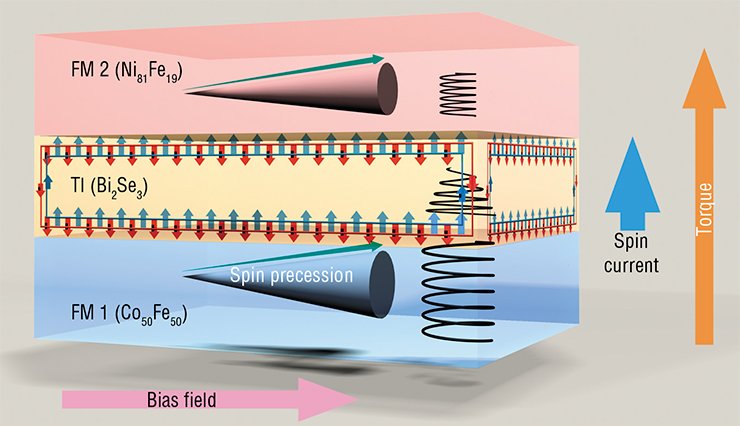
A substantial improvement in magnetic information storage has come from the advances in spintronics, a rapidly evolving field of instrument technology, which is based on the manipulation of electron spins. However, the development of spintronic analogues of electronic devices is much more challenging. Recently, a collaboration of experimenters and theorists from seven countries in Europe and Asia have shown that the WSe2 semiconductor exhibits superficial spin-polarized electron states while retaining the bulk inversion symmetry. This study, which used Beamline I05 for photo emission spectroscopy measurements, opens up a possibility for developing a new class of materials in which the spin states can be controlled. These materials will be of great interest to a number of logical applications.
Certainly, the generation and use of synchrotron light is a hard-to-grasp subject since there is nothing to touch or see. Diamond has a special Communications Team, and the outreach is organized in such a way that Diamond communicates with the general public through all generations, from schoolchildren to grand-parents. The facility also encourages staff to bring their families to Diamond. In the run up to Christmas 2014, Diamond organized an unusual event for staff children where they built a minimodel of Diamond from Lego. When complex knowledge is delivered in the form of a game, any child can see how teamwork is organized within this huge synchrotron facility.
The scope of the outreach activities includes a constantly updated news section on the Diamond website; briefings and interviews with journalists who come literally every week; school lectures by Diamond staff; hosting its own exhibitions on various themes and participation in national exhibitions; and, of course, popular science publications.
When communicating with the general public, the focus is a mix of the technical side of generating the synchrotron light and the applications, from archaeology to pharmaceutics, which arouse interest and are simple enough to understand. After all, most of us tend to be interested in the purpose of a technical device rather than in its design. It is always possible to find a reasonable balance between scientific terminology and comprehensibility of the information that is brought to the general public.
It is impossible to list all the interesting discoveries made at Diamond throughout its eight-year history. We can only mention that over this period, the DLS staff together with the users have published more than 4,000 research papers in the most relevant fields ranging from molecular biology and medicine to electronics.
To keep the facility at the forefront of the global synchrotron science, Diamond is now designing a 10-year development strategy, which is based on the successful experience of interaction with other research institutions in such areas as radiation detectors design, new instruments for electron microscopy, etc.
Thus, the facility could be significantly upgraded by 2022. The underlying goal is to ensure that in the 21st century the United Kingdom will have the best possible universal research tool to explore the world, and synchrotron radiation is such a tool today.
This article is partly based on the materials of the Diamond Light Source website http://www.diamond.ac.uk
Editors of SCIENCE First Hand thank Diamond Light Source Ltd and the UK Science and Innovation Network (SIN)–Russia, based in the British Embassy in Moscow, for their help in preparing this publication


